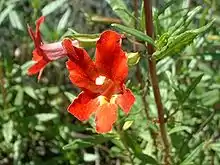Diplacus aurantiacus
Diplacus aurantiacus, the sticky monkey-flower or orange bush monkey-flower, is a flowering plant that grows in a subshrub form, native to southwestern North America from southwestern Oregon south through most of California. It is a member of the lopseed family, Phrymaceae. It was formerly known as Mimulus aurantiacus.[2][1][3][4][5]
| Diplacus aurantiacus | |
|---|---|
 | |
| Scientific classification | |
| Kingdom: | Plantae |
| Clade: | Tracheophytes |
| Clade: | Angiosperms |
| Clade: | Eudicots |
| Clade: | Asterids |
| Order: | Lamiales |
| Family: | Phrymaceae |
| Genus: | Diplacus |
| Species: | D. aurantiacus |
| Binomial name | |
| Diplacus aurantiacus | |
| Synonyms[1] | |
| |
Description
Diplacus aurantiacus grows up to 1.2 meters (4 feet) tall, has deep green, sticky leaves 3 to 7 centimeters long and up to a centimeter broad and flowering stems that grow vertically.[2] The flowers are tubular at the base and about 2 centimeters long with five broad lobes; they occur in a variety of shades from white to red, the most common color being a light orange. They are honey plants pollinated by bees and hummingbirds.
It grows in many climates and will thrive in many types of soil, wet, dry, sandy, or rocky. It even grows in serpentine, a soil that most plants have difficulty thriving in because of its unique mineral composition.
Diplacus aurantiacus is an important host plant for the larvae of the common buckeye butterfly (Junonia coenia) and the variable checkerspot (Euphydryas chalcedona),[6] despite a phenolic resin in the leaves which deter its feeding.[7] This resin also helps the plant retain water in dry environments.[7]
Cultivation
This bushy evergreen shrub can be short-lived in cultivation. The species and its cultivars are used in water conserving, native plant, and habitat gardens.[8] As it does not tolerate freezing temperatures, it is often grown under glass in temperate zones. In the UK it has won the Royal Horticultural Society's Award of Garden Merit.[9]
Traditional Native American medical plant
The Miwok and Pomo Native Americans used the plant to treat minor ailments such as sores, burns, diarrhea, and eye irritation. They used the colorful flowers for decorative purposes.[10]
Gallery
References
- Barker, W.R.; Nesom, G.L.; Beardsley, P.M.; Fraga, N.S. (2012), "A taxonomic conspectus of Phrymaceae: A narrowed circumscriptions for Mimulus, new and resurrected genera, and new names and combinations" (PDF), Phytoneuron, 2012–39: 1–60CS1 maint: uses authors parameter (link)
- Mimulus aurantiacus. The Jepson Manual.
- Beardsley, P. M.; Yen, Alan; Olmstead, R. G. (2003). "AFLP Phylogeny of Mimulus Section Erythranthe and the Evolution of Hummingbird Pollination". Evolution. 57 (6): 1397–1410. doi:10.1111/j.0014-3820.2003.tb00347.x. JSTOR 3448862. PMID 12894947. S2CID 14119163.
- Beardsley, P. M.; Olmstead, R. G. (2002). "Redefining Phrymaceae: the placement of Mimulus, tribe Mimuleae, and Phryma". American Journal of Botany. 89 (7): 1093–1102. doi:10.3732/ajb.89.7.1093. JSTOR 4122195. PMID 21665709.
- Beardsley, P. M.; Schoenig, Steve E.; Whittall, Justen B.; Olmstead, Richard G. (2004). "Patterns of Evolution in Western North American Mimulus (Phrymaceae)". American Journal of Botany. 91 (3): 474–4890. doi:10.3732/ajb.91.3.474. JSTOR 4123743. PMID 21653403.
- Mimulus aurantiacus. California Wildflowers. California Academy of Sciences.
- Han, K.; Lincoln, D. E. (1994). "The evolution of carbon allocation to plant secondary metabolites: a genetic analysis of cost in Diplacus aurantiacus". Evolution. 48 (5): 1550–63. doi:10.1111/j.1558-5646.1994.tb02195.x. JSTOR 2410247. PMID 28568412. S2CID 10252479.
- Nickel, E. Mimulus are exotic natives of California. San Francisco Chronicle August 8, 2013.
- "Mimulus auriantacus". www.rhs.org. Royal Horticultural Society. Retrieved 3 January 2021.
- Sticky Monkey Flower. Presidio of San Francisco. National Park Service.
External links
| Wikimedia Commons has media related to Mimulus aurantiacus. |
- Mimulus aurantiacus. CalFlora.
- USDA Plants profile for Diplacus aurantiacus. USDA PLANTS.
- ITIS−Integrated Taxonomic Information System: Diplacus aurantiacus. Integrated Taxonomic Information System (ITIS)
- Mimulus aurantiacus. CalPhotos.






